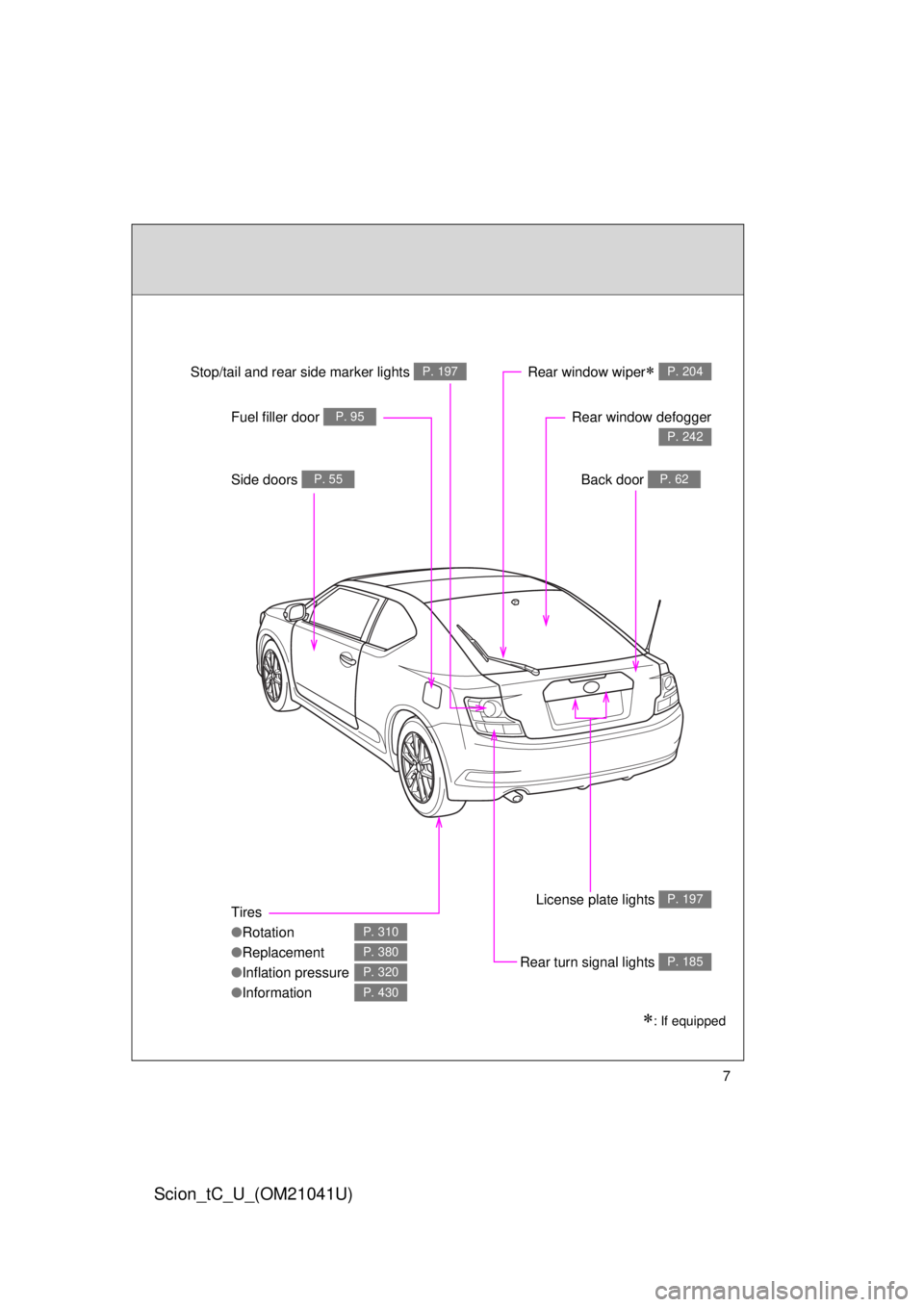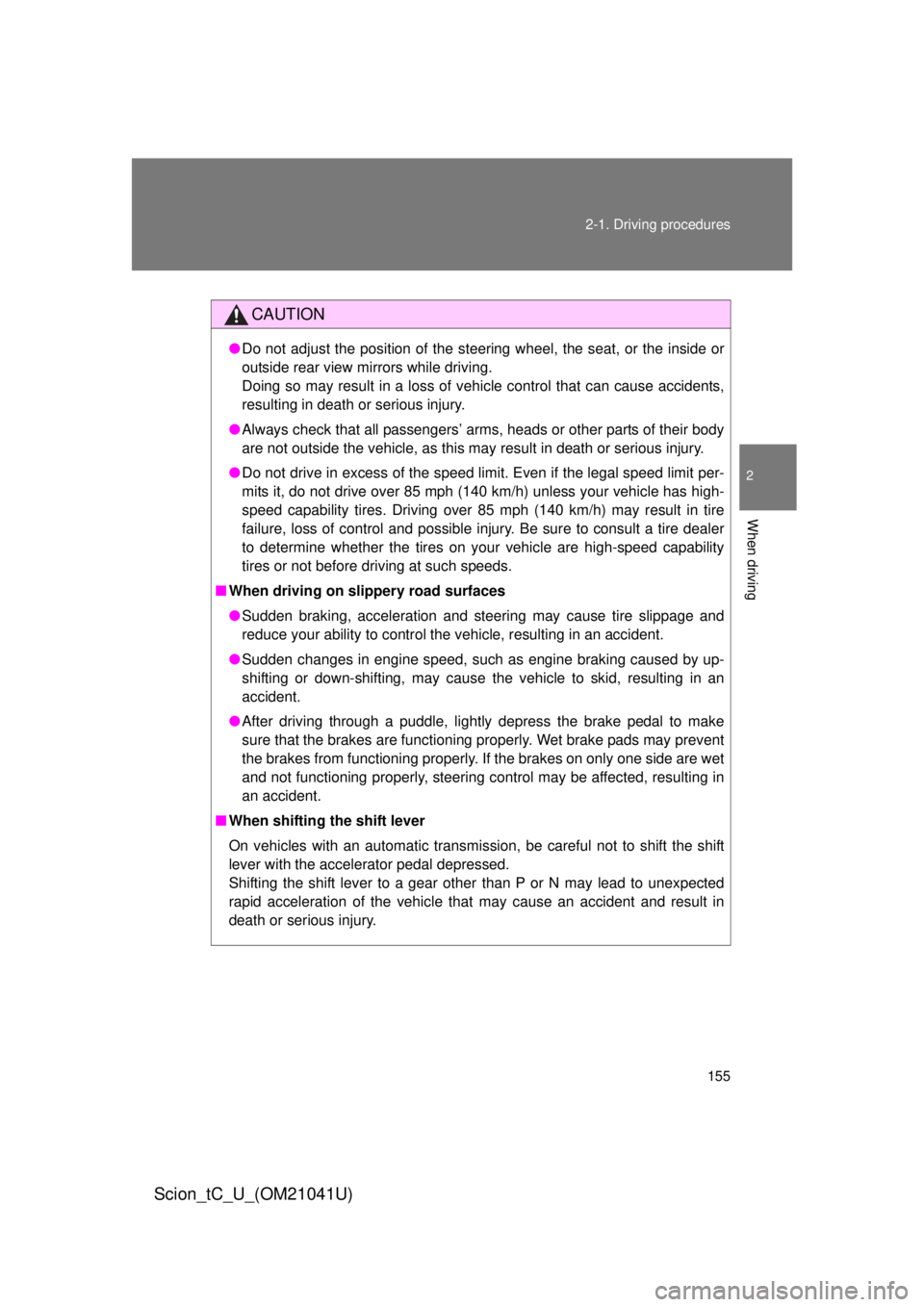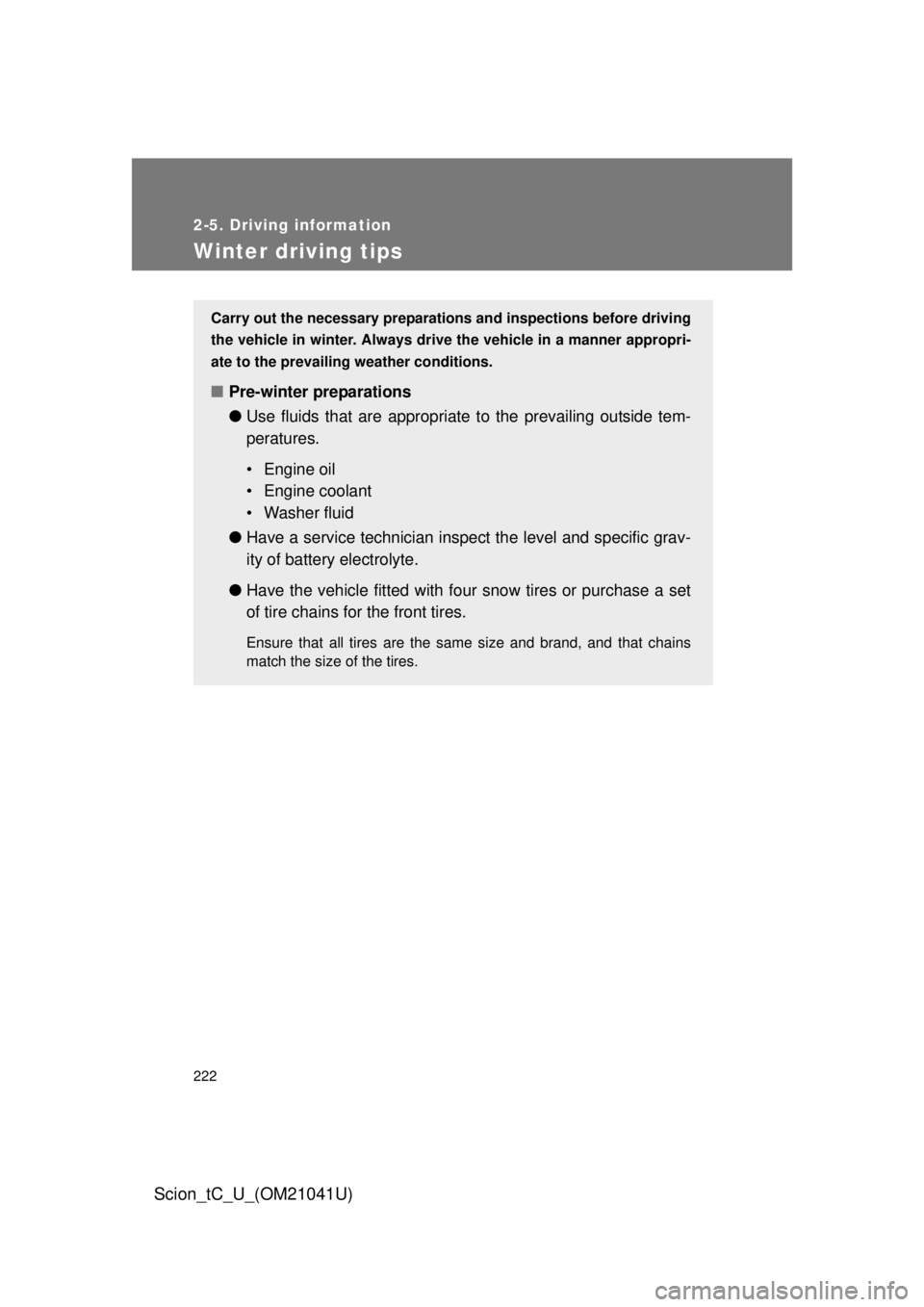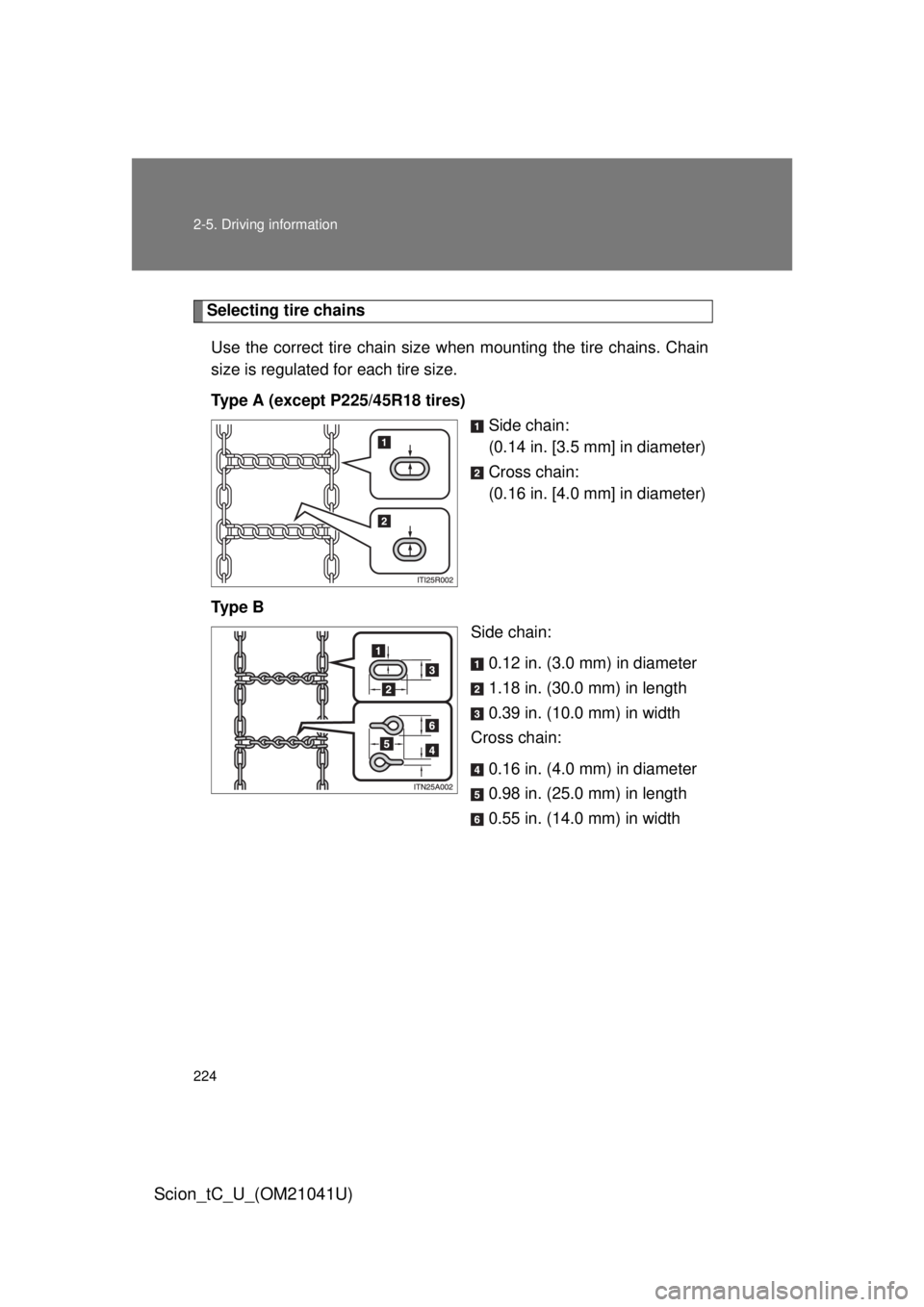tires TOYOTA tC 2012 Owners Manual (in English)
[x] Cancel search | Manufacturer: TOYOTA, Model Year: 2012, Model line: tC, Model: TOYOTA tC 2012Pages: 480, PDF Size: 9.44 MB
Page 4 of 480

TABLE OF CONTENTSIndex
4
Scion_tC_U_(OM21041U)
4-1. Maintenance and careCleaning and protecting
the vehicle exterior ........... 270
Cleaning and protecting
the vehicle interior ............ 274
4-2. Maintenance Maintenance
requirements .................... 277
General maintenance ......... 280
Emission inspection and
maintenance (I/M)
programs .......................... 284
4-3. Do-it-yourself maintenance Do-it-yourself service
precautions ...................... 285
Hood................................... 290
Positioning a floor jack ....... 292
Engine compartment .......... 294
Tires ................................... 310
Tire inflation pressure......... 320
Wheels ............................... 324
Wireless remote control/
electronic key battery ....... 326
Checking and replacing
fuses ................................ 330
Light bulbs .......................... 341 5-1. Essential information
Emergency flashers ............ 352
If your vehicle needs to be
towed ................................ 353
If you think something is wrong ................................ 361
Fuel pump shut off
system .............................. 362
5-2. Steps to take in an emergency If a warning light turns
on or a warning buzzer
sounds... ........................... 363
If you have a flat tire ........... 380
If the engine will not start .... 395
If the shift lever cannot be
shifted from P (automatic
transmission) .................... 398
If you lose your keys ........... 399
If the electronic key does not
operate properly ............... 400
If the vehicle battery is dis- charged ............................ 404
If your vehicle overheats..... 408
If the vehicle becomes
stuck ................................. 411
If your vehicle has to be
stopped in an
emergency ........................ 413
4Maintenance and care5When trouble arises
Page 7 of 480

7
Scion_tC_U_(OM21041U)
: If equipped
Tires
●Rotation
● Replacement
● Inflation pressure
● Information
P. 310
P. 380
P. 320
P. 430
License plate lights P. 197
Rear turn signal lights P. 185
Side doors P. 55
Stop/tail and rear side marker lights P. 197Rear window wiper P. 204
Fuel filler door P. 95Rear window defogger
P. 242
Back door P. 62
Page 151 of 480

151
2-1. Driving procedures
2
When driving
Scion_tC_U_(OM21041U)
■
Driving in the rain
● Drive carefully when it is raining, because visibility will be reduced, the
windows may become fogged-up, and the road will be slippery.
● Drive carefully when it starts to rain, because the road surface will be
especially slippery.
● Refrain from high speeds when driving on an expressway in the rain,
because there may be a layer of water between the tires and the road
surface, preventing the steering and brakes from operating properly.
■ Breaking in your new Scion
To extend the life of the vehicle, observing the following precautions is rec-
ommended:
● For the first 200 miles (300 km):
Avoid sudden stops.
● For the first 1000 miles (1600 km):
• Do not drive at extremely high speeds.
• Avoid sudden acceleration.
• Do not drive continuously in low gears.
• Do not drive at a constant speed for extended periods.
■ Operating your vehicle in a foreign country
Comply with the relevant vehicle registration laws and confirm the availability
of the correct fuel. ( P. 418)
Page 155 of 480

155
2-1. Driving procedures
2
When driving
Scion_tC_U_(OM21041U)
CAUTION
●
Do not adjust the position of the steering wheel, the seat, or the inside or
outside rear view mirrors while driving.
Doing so may result in a loss of vehicle control that can cause accidents,
resulting in death or serious injury.
● Always check that all passengers’ arms, heads or other parts of their body
are not outside the vehicle, as this may result in death or serious injury.
● Do not drive in excess of the speed limit. Even if the legal speed limit per-
mits it, do not drive over 85 mph (140 km/h) unless your vehicle has high-
speed capability tires. Driving over 85 mph (140 km/h) may result in tire
failure, loss of control and possible injury. Be sure to consult a tire dealer
to determine whether the tires on your vehicle are high-speed capability
tires or not before driving at such speeds.
■ When driving on slippery road surfaces
● Sudden braking, acceleration and steering may cause tire slippage and
reduce your ability to control the vehicle, resulting in an accident.
● Sudden changes in engine speed, such as engine braking caused by up-
shifting or down-shifting, may cause the vehicle to skid, resulting in an
accident.
● After driving through a puddle, lightly depress the brake pedal to make
sure that the brakes are functioning properly. Wet brake pads may prevent
the brakes from functioning properly. If the brakes on only one side are wet
and not functioning properly, steering control may be affected, resulting in
an accident.
■ When shifting the shift lever
On vehicles with an automatic transmission, be careful not to shift the shift
lever with the accelerator pedal depressed.
Shifting the shift lever to a gear other than P or N may lead to unexpected
rapid acceleration of the vehicle that may cause an accident and result in
death or serious injury.
Page 214 of 480

214 2-4. Using other driving systems
Scion_tC_U_(OM21041U)
CAUTION
■The ABS does not operate effectively when
● Tires with inadequate gripping ability are used (such as excessively worn
tires on a snow covered road).
● The vehicle hydroplanes while driving at high speed on wet or slick roads.
■ Stopping distance when the ABS is operating may exceed that of nor-
mal conditions
The ABS is not designed to shorten the vehicle’s stopping distance. Always
maintain a safe distance from the vehicle in front of you in the following situ-
ations:
● When driving on dirt, gravel or snow-covered roads
● When driving with tire chains
● When driving over bumps in the road
● When driving over roads with potholes or roads with uneven surfaces
■ TRAC may not operate effectively when
Directional control and power may not be achievable while driving on slip-
pery road surfaces, even if the TRAC system is operating.
Do not drive the vehicle in conditions where stability and power may be lost.
■ When VSC is activated
The slip indicator light flashes. Always drive carefully. Reckless driving may
cause an accident. Exercise particular care when the indicator light flashes.
■ When the TRAC/VSC syst ems are turned off
Be especially careful and drive at a speed appropriate to the road condi-
tions. As these are systems to ensure vehicle stability and driving force, do
not turn the TRAC/VSC systems off unless necessary.
Page 215 of 480

215
2-4. Using other
driving systems
2
When driving
Scion_tC_U_(OM21041U)
CAUTION
■Replacing tires
Make sure that all tires are of the specified size, brand, tread pattern and
total load capacity. In addition, make sure that the tires are inflated to the
recommended tire inflation pressure level.
The ABS and VSC systems will not function correctly if different tires are
installed on the vehicle.
Contact your Scion dealer for further information when replacing tires or
wheels.
■ Handling of tires and the suspension
Using tires with any kind of problem or modifying the suspension will affect
the driving assist systems, and may cause a system to malfunction.
Page 222 of 480

222
2-5. Driving information
Scion_tC_U_(OM21041U)
Winter driving tips
Carry out the necessary preparations and inspections before driving
the vehicle in winter. Always drive the vehicle in a manner appropri-
ate to the prevailing weather conditions.
■ Pre-winter preparations
●Use fluids that are appropriate to the prevailing outside tem-
peratures.
• Engine oil
• Engine coolant
• Washer fluid
● Have a service technician inspect the level and specific grav-
ity of battery electrolyte.
● Have the vehicle fitted with four snow tires or purchase a set
of tire chains for the front tires.
Ensure that all tires are the same size and brand, and that chains
match the size of the tires.
Page 224 of 480

224 2-5. Driving information
Scion_tC_U_(OM21041U)
Selecting tire chainsUse the correct tire chain size when mounting the tire chains. Chain
size is regulated for each tire size.
Type A (except P225/45R18 tires)
Side chain:
(0.14 in. [3.5 mm] in diameter)
Cross chain:
(0.16 in. [4.0 mm] in diameter)
Ty p e B Side chain:
0.12 in. (3.0 mm) in diameter
1.18 in. (30.0 mm) in length
0.39 in. (10.0 mm) in width
Cross chain:
0.16 in. (4.0 mm) in diameter
0.98 in. (25.0 mm) in length
0.55 in. (14.0 mm) in width
Page 225 of 480

225
2-5. Driving information
2
When driving
Scion_tC_U_(OM21041U)
Regulations on the use of tire chains
Regulations regarding the use of ti re chains vary depending on loca-
tion and type of road. Always chec k local regulations before installing
chains.
■ Tire chain installation
Observe the following precautions when installing and removing chains:
● Install and remove tire chains in a safe location.
● Install tire chains on the front tires only. Do not install tire chains on the
rear tires.
● Install tire chains on front tires as tightly as possible. Retighten chains
after driving 1/4 - 1/2 mile (0.5 - 1.0 km).
● Install tire chains following the instructions provided with the tire chains.
Page 226 of 480

226 2-5. Driving information
Scion_tC_U_(OM21041U)
CAUTION
■Driving with snow tires
Observe the following precautions to reduce the risk of accidents.
Failure to do so may result in a loss of vehicle control and cause death or
serious injury.
● Use tires of the size specified.
● Maintain the recommended level of air pressure.
● Do not drive in excess of 75 mph (120 km/h), regardless of the type of
snow tires being used.
● Use snow tires on all, not just some wheels.
■ Driving with tire chains
Observe the following precautions to reduce the risk of accidents.
Failure to do so may result in the vehicle being unable to be driven safely,
and may cause death or serious injury.
● Do not drive in excess of the speed limit specified for the tire chains being
used, or 30 mph (50 km/h), whichever is lower.
● Avoid driving on bumpy road surfaces or over potholes.
● Avoid sudden turns and braking, as use of chains may adversely affect
vehicle handling.
● Slow down sufficiently before entering a curve to ensure that vehicle con-
trol is maintained.